PANASONIC Toughbook CF-18 User Manual
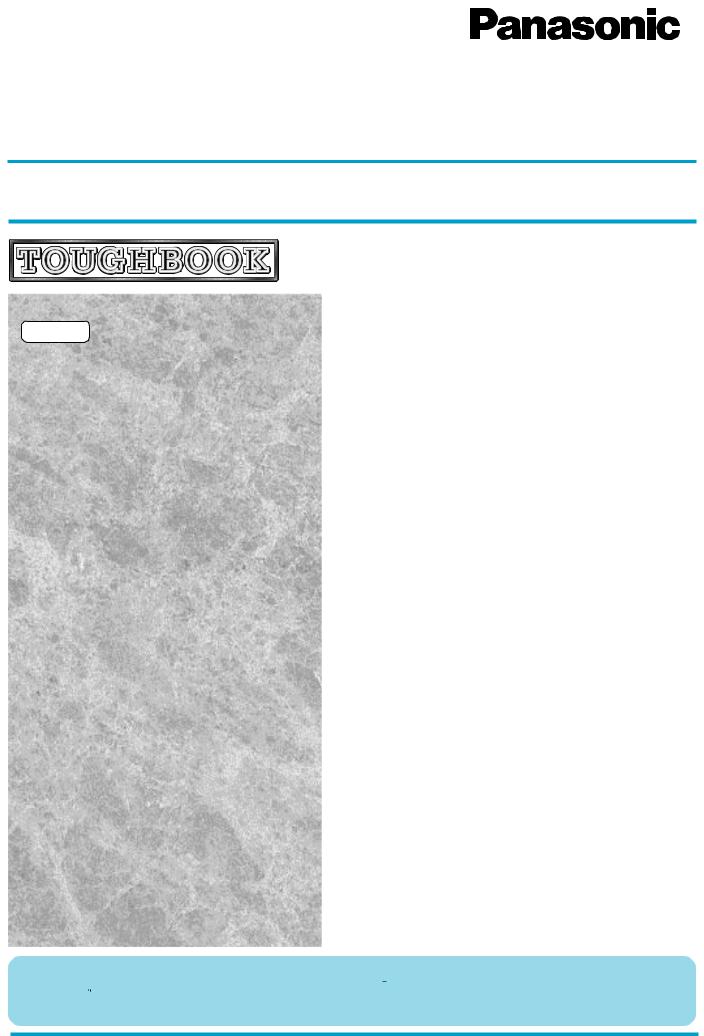
®
Personal Computer
Reference Manual
Model No. CF-18 Series
|
Contents |
|
|
Read Me First ...................................................... |
2 |
Tablet PC |
Key Combinations .............................................. |
3 |
|
LED Indicators .................................................... |
6 |
|
Tablet Buttons ..................................................... |
7 |
|
Touch Pad (Advanced) .......................................... |
8 |
|
Digitizer (Advanced).................................................... |
14 |
|
Display Rotation .............................................. |
17 |
|
Standby/Hibernation Functions ..................... |
20 |
|
Security Measures ........................................... |
24 |
|
Computing on the Road .................................. |
28 |
|
Battery Power .................................................. |
29 |
|
PC Cards .......................................................... |
35 |
|
RAM Module ..................................................... |
38 |
|
Port Replicator ................................................. |
40 |
|
External Display .............................................. |
41 |
|
USB Devices .................................................... |
44 |
|
Modem .............................................................. |
46 |
|
LAN ................................................................... |
48 |
|
Wireless LAN ................................................... |
50 |
|
Hard Disk Drive ................................................ |
53 |
|
Setup Utility ..................................................... |
55 |
|
Technical Information ..................................... |
60 |
|
DMI Viewer ....................................................... |
61 |
|
List of Error Codes .......................................... |
62 |
|
Dealing with Problems (Advanced) ................... |
63 |
When the cursor is moved to an item under [Contents] or to  page (green display), the shape of the cursor will change to
page (green display), the shape of the cursor will change to  . Under this condition, if characters are tapped (or a click is made), the corresponding page in the Reference Manual will be displayed.
. Under this condition, if characters are tapped (or a click is made), the corresponding page in the Reference Manual will be displayed.
We recommend that this Reference Manual be printed.

Read Me First
2
 If the user has logged on without the administrator authority, some functions may not be executable, and some screens may be not displayed as shown in this manual. If this happens, log on with administrator authority to enable these functions.
If the user has logged on without the administrator authority, some functions may not be executable, and some screens may be not displayed as shown in this manual. If this happens, log on with administrator authority to enable these functions.
 Confirm the latest information on optional products in catalogs, etc.
Confirm the latest information on optional products in catalogs, etc.
Illustrations used in this Reference Manual
NOTE: CAUTION:
WARNING:
Enter :
Fn + F5 :
[start] - [Run]:

 :
:
NOTE provides a useful fact or helpful information.
CAUTION indicates a condition that may result in minor or moderate injury.
WARNING indicates a hazard that may result in moderate or serious injury.
This illustration means to press the [Enter] key.
This illustration means to press and hold the [Fn] key, then press the [F5] key.
This illustration means to click [start], then to click [Run]. For some applications, you may need to double-click.
This illustration means to refer to the Operating Instructions or Supplementary Instructions.
 Some of the illustrations in this manual may differ slightly in shape from the actual items in order to make the explanation easier to understand.
Some of the illustrations in this manual may differ slightly in shape from the actual items in order to make the explanation easier to understand.
 About the terminology used in this manual and the Setup Utility concerning the internal LCD and an external display
About the terminology used in this manual and the Setup Utility concerning the internal LCD and an external display
|
This manual and the |
[Intel(R) 82852/82855 GM/ |
|
Setup Utility |
GME Graphics Controller |
|
|
Properties]* |
To display the same screen |
Simultaneous display |
Intel(R) Dual Display Clone |
on both the LCD and exter- |
|
|
nal display |
|
|
* Select [start] - [Control Panel] - [Other Control Panel Options] - [Intel(R) Extreme Graphics].
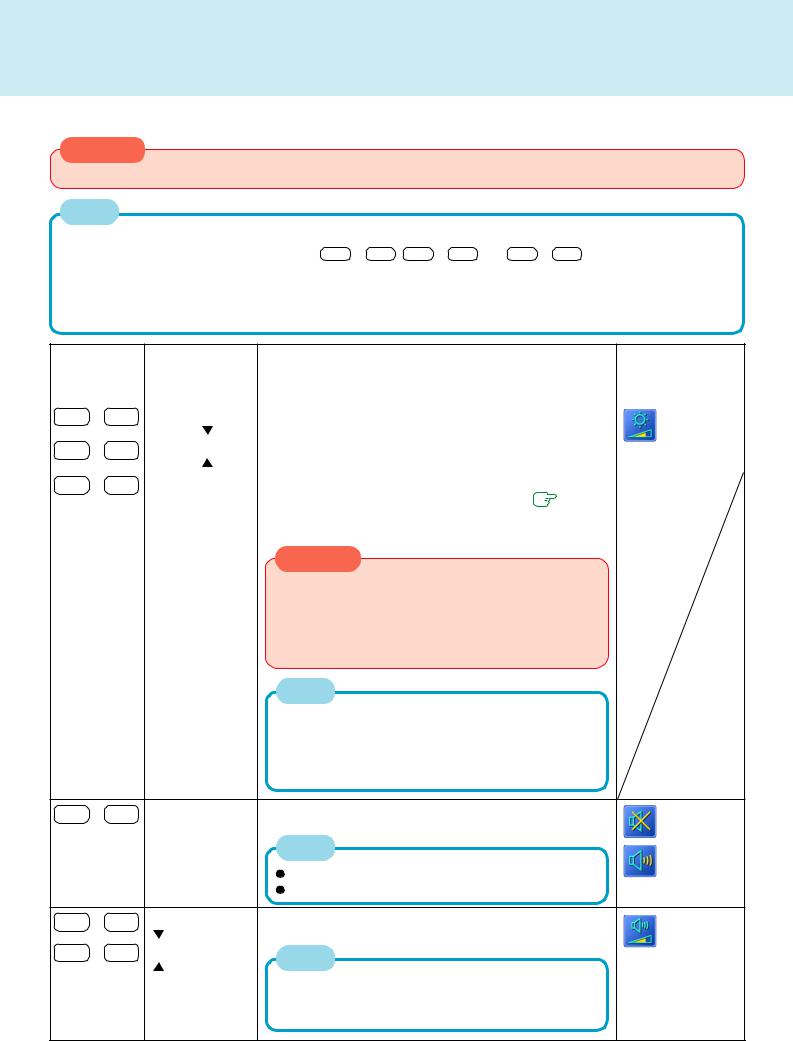
Key Combinations
3
CAUTION
Do not press the following key combinations while using the touch pad (mouse), the digitizer or other keys.
NOTE
 Do not press the following key combinations until you log on to Windows and the hard disk drive indicator turns off. Note, however, that the key combinations Fn + F1 , Fn + F2 and Fn + F3 are operable in the Setup Utility.
Do not press the following key combinations until you log on to Windows and the hard disk drive indicator turns off. Note, however, that the key combinations Fn + F1 , Fn + F2 and Fn + F3 are operable in the Setup Utility.
 The key combinations below may not work while some applications are running. Besides, the popup window may not be displayed depending on the state of the application you are using(e.g., when the [Command Prompt] screen is set to “Full Screen”).
The key combinations below may not work while some applications are running. Besides, the popup window may not be displayed depending on the state of the application you are using(e.g., when the [Command Prompt] screen is set to “Full Screen”).
Key |
Functions |
Function Descriptions |
|
Popup Window |
|
|
|
|
(Displayed after log- |
|
|
|
|
ging on to Windows) |
Fn + F1 |
LCD brightness |
Pressing this key combination adjusts the brightness of LCD. |
||
|
control ( down) |
The brightness setting is stored in memory separately un- |
||
Fn + F2 |
LCD brightness |
der the condition the AC adaptor is connected and under |
||
|
control ( up) |
the condition the AC adaptor is not connected. |
|
|
Fn + F3 |
Display change |
By pressing this key combination, you can select either an |
||
|
|
external display, internal LCD or simultaneous. ( |
|
page 41) |
|
|
This key combination does not work when the [Command |
||
|
|
Prompt] screen is set to “Full Screen” . |
|
|
CAUTION
 Do not press another key until the display destination has been completely switched.
Do not press another key until the display destination has been completely switched.
 Do not press this key combination in the following conditions.
Do not press this key combination in the following conditions.
•While MPEG files are playing
•When the Extended Desktop is being utilized
NOTE
When switching to a different user with the Fast User Switching function, this key operation may not work. In this case, log on with the administrator authority again, not using the Fast User Switching function, and try the operation once more.
Fn + F4 |
Speakers on/off |
Pressing this key combination turns on/off audio from the |
OFF |
|
switch |
internal speakers and headphone jack. |
|
|
|
NOTE |
ON |
|
|
Disabling the speakers will also disable the warning beep. |
|
|
|
|
|
|
|
Speakers connected to the USB port cannot be muted. |
|
Fn + F5 |
Volume control |
Pressing this key combination adjusts the volume of the in- |
|
|
( down) |
ternal speaker and headphone jack. |
|
Fn + F6 |
Volume control |
NOTE |
|
|
( up) |
|
|
This key combination cannot be used to adjust the volume of the warning beep or speakers connected to the USB port.

Key Combinations
4
Key |
Functions |
Function Descriptions |
|
|
Popup Window |
|||||
|
|
|
|
|
|
|
|
|
|
(Displayed after log- |
|
|
|
|
|
|
|
|
|
|
ging on to Windows) |
Fn + F7 |
Power off using |
Pressing this key combination causes the current status of |
|
|||||||
|
t h e s t a n d b y |
the computer to be saved to memory, and powers off the |
|
|||||||
|
function |
computer. ( |
|
|
page 20) |
|
|
|
||
|
|
|
|
|
||||||
|
|
|
|
|
|
|
|
|||
Fn + F9 |
Remaining ca- |
Pressing this key combination displays the remaining bat- |
Remaining |
|||||||
|
pacity of the bat- |
tery capacity on the screen. ( |
|
page 30) |
capacity (%) |
|||||
|
tery pack |
|
|
|
|
|
|
|
|
|
|
|
|
|
|
|
|
|
|
display |
|
|
|
|
|
|
|
|
|
|
|
Battery pack is |
|
|
|
|
|
|
|
|
|
|
not inserted. |
|
|
|
|
|
|
|||||
Fn + F10 |
Power off using |
Pressing this key combination causes the current status of |
|
|||||||
|
the hibernation |
the computer to be saved to the hard disk, and powers off |
|
|||||||
|
function |
the computer. ( |
|
|
page 20) |
|
|
|
||
|
|
|
|
|
|
|||||
|
|
|
|
|
|
|
|
|
|
|

Key Combinations
5
Hotkey Settings
There are two Fn key functions as follows:  Fn key lock function
Fn key lock function
After Fn is pressed once, it stays in the “pressed” position until another key is pressed. This is convenient when it is difficult to press two buttons simultaneously.  Popup windows display ON/OFF
Popup windows display ON/OFF
Settings
1 Run the Hotkey Settings.
Select [start]-[All Programs]-[Panasonic]-[Hotkey Settings].
2 Set the parameters.
Add the check mark if you want to enable the Fn key lock function. The following Fn key lock function will then be enabled.
To use |
Fn |
only once: |
1 |
Press Fn once. (Locked) |
|
Fn |
|
2 |
Press another key for combination. (Lock released) |
To use |
successively: 1 |
Press Fn twice. (Locked) |
||
|
|
|
2 |
Press another key for combination. |
|
|
|
|
Fn key remains locked until Fn is pressed once |
|
|
|
|
more. |
This setting is only available when [Use Fn key lock] is checked.  [Make sounds when Fn key is pressed]*1:
[Make sounds when Fn key is pressed]*1:
Notifies the user with a sound when Fn is pressed, locked, or released.  [Show status on screen]:
[Show status on screen]:
Displays the Fn key status on the taskbar.
 : Fn is locked
: Fn is locked
 : Fn is not locked
: Fn is not locked
Add the check mark if you want to turn the popup window display function OFF. The full-screen display of [Command Prompt] screen or MPEG files may change to a window display if Fn + Fx *2 keys are pressed. To prevent this, turn the popup window display function OFF.
3 Select [OK].
NOTE
The Fn key lock function also works with Fn and other keys (e.g., |
, |
) |
aside from Fx *2. |
|
|
 Each user can select separate settings for whether or not to use the Hotkey settings.
Each user can select separate settings for whether or not to use the Hotkey settings.
*1 If MUTE is set, you will not hear a beep.
*2 “ Fx ” indicates any function key from F1 to F10 .
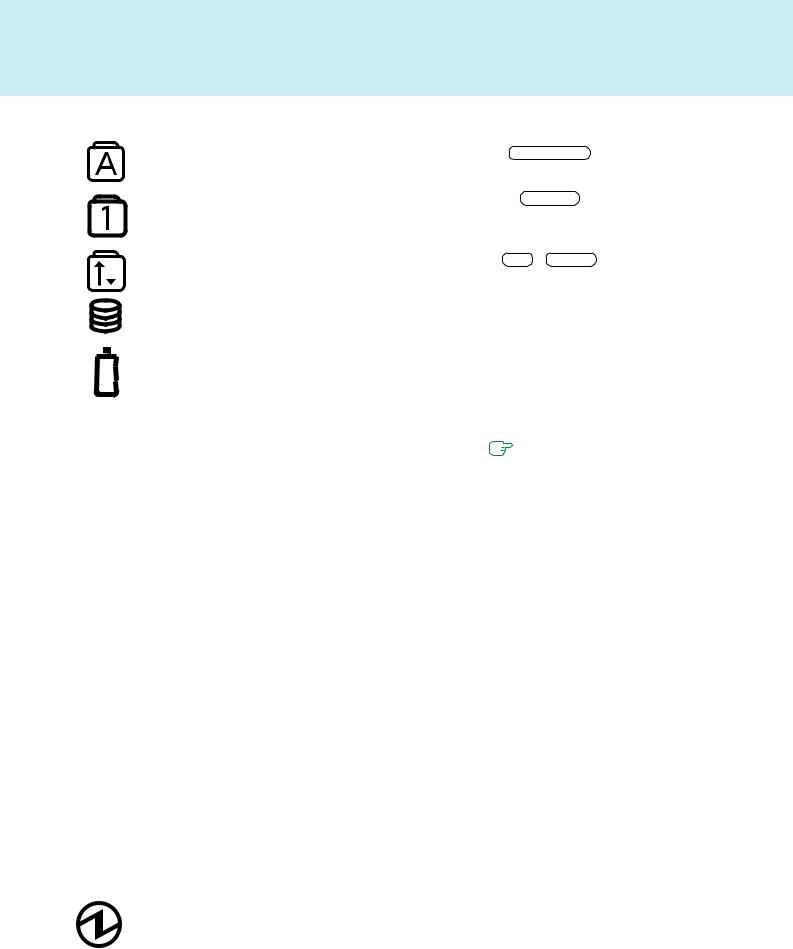
LED Indicators
6
|
|
Caps Lock |
This indicator lights green when |
Caps Lock |
is pressed. Subsequent |
|||
|
|
|
non-shifted input is capitalized. |
|
|
|||
|
|
|
|
|
|
|
||
|
|
NumLk (Numeric key) |
These indicators light green when NumLk |
is pressed. This causes a |
||||
|
|
|
portion of the keyboard to function as a numeric keypad. The [Enter] key |
|||||
|
|
|
functions differently depending on the application. |
|||||
|
|
|
|
|
|
|
||
|
|
ScrLk (Scroll lock) |
This indicator lights green when |
Fn + ScrLk are pressed. Scroll lock |
||||
|
||||||||
|
|
|
functions differently depending on the application. |
|||||
|
|
|
|
|
|
|
|
|
|
|
Hard disk drive |
This indicator lights when the hard disk drive is accessed. |
|||||
|
|
status |
|
|
|
|
|
|
|
|
|
|
|
|
|
||
|
|
Battery pack |
Not lit : |
Battery pack is not connected or charging not be- |
||||
|
|
status |
Orange*1: |
ing performed. |
|
|||
|
|
|
Charging in progress. |
|
||||
|
|
|
Green*1 : |
Fully-charged. |
|
|||
|
|
|
Blinking green : |
In high temperature mode, the battery pack is dis- |
||||
|
|
|
|
charging to a level of 80%*2 in normal temperature |
||||
|
|
|
|
mode. ( |
|
|
page 31) |
|
|
|
|
|
|
|
|||
|
|
|
|
Do not remove the battery pack while the battery |
||||
|
|
|
Red : |
indicator is blinking green. |
||||
|
|
|
The battery level is very low (the charge is less than |
|||||
|
|
|
|
approx. 9% capacity). |
|
|||
|
|
|
|
Connect the AC adaptor. You can use the computer |
||||
|
|
|
|
when the indicator light is orange. If you do not |
||||
|
|
|
|
have an AC adaptor, save your data and power off |
||||
|
|
|
|
your computer. After replacing the battery pack with |
||||
|
|
|
Blinking red*1 : |
a fully charged one, turn your computer on. |
||||
|
|
|
Battery pack or charging may not be working prop- |
|||||
|
|
|
|
erly. Quickly save your data and power off your |
||||
|
|
|
|
computer. |
|
|
||
|
|
|
|
Remove the battery pack and disconnect the AC |
||||
|
|
|
|
adaptor, then connect them again. |
||||
|
|
|
|
If the problem persists, contact Panasonic Techni- |
||||
|
|
|
|
cal Support. |
|
|||
|
|
|
Blinking orange*1 : Battery cannot be recharged temporarily because |
|||||
|
|
|
|
the internal temperature of the battery pack is out- |
||||
|
|
|
|
side of the acceptable temperature range for re- |
||||
|
|
|
|
charging. Once the allowable range requirement is |
||||
|
|
|
|
satisfied, charging begins automatically. Your com- |
||||
|
|
|
|
puter can be used normally. |
||||
|
|
|
Blinking green and orange alternately: |
|
||||
|
|
|
|
Warming up the system to prevent hard disk drive |
||||
|
|
|
|
malfunctions at low temperature. Leave your com- |
||||
|
|
|
|
puter as is. Once the allowable range requirement |
||||
|
|
|
|
is satisfied, your computer will start automatically. |
||||
|
|
|
|
|
|
|
||
|
|
Power status |
Not lit : |
Power off / Hibernation mode |
||||
|
|
|
Green : |
Power on |
|
|
||
|
|
|
Blinking green : Standby mode |
|
||||
|
|
|
|
|
|
|
|
|
*1 When the AC adaptor is connected.
*2 A level of 80% in normal temperature mode is displayed as [100%] in high temperature mode.
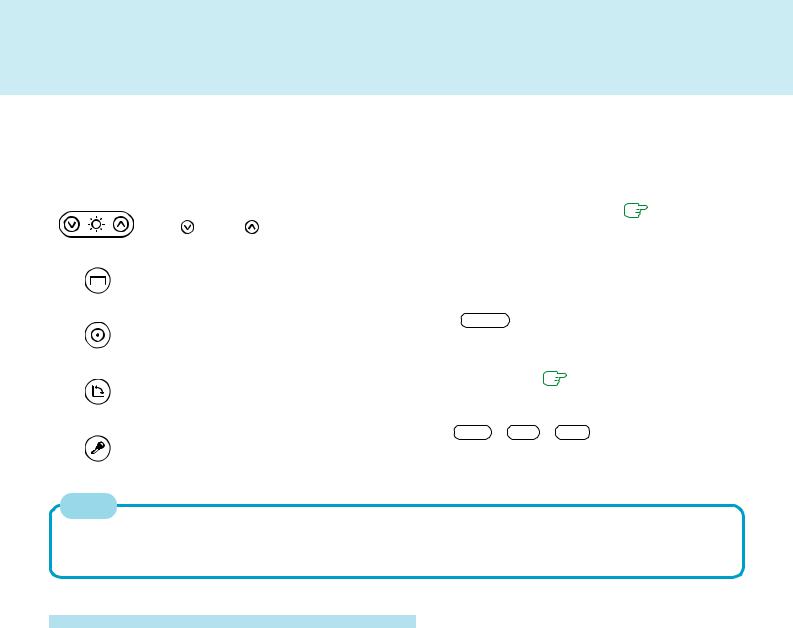
Tablet Buttons
7
When the Windows screen is displayed, you can use the tablet buttons to perform the following operations.
Button |
Functions |
Function Descriptions |
|
|
|
|
|
LCD brightness con- |
Pressing these buttons adjust the brightness of LCD. ( |
|
page 3) |
||
|
|
|||||
|
trol ( down / up) |
|
|
|
|
|
|
|
|
|
|
||
|
Input Panel |
Pressing this buttons starts up the Tablet PC Input Panel. For detailed |
||||
|
|
information, refer to Windows help. (This button will not work on the Wel- |
||||
|
|
come screen.) |
|
|
|
|
|
Enter |
Same operations as when Enter is pressed. |
|
|
||
|
|
|
|
|
|
|
|
Rotation |
Pressing this button rotates the display. ( |
|
page 17) |
|
|
|
|
|
|
|||
|
|
|
|
|
||
|
Security |
Same operation as when Ctrl + Alt + |
|
Del are pressed. |
||
|
|
|
|
|
|
|
NOTE
When you press the tablet button, there may be cases that the message “Your tablet computer can not perform this action. For assistance, contact your software manufacturer.” is displayed. This, however, is not a malfunction. Select [OK] and press the button again.
Changing the Settings of Tablet Buttons
The input panel, enter, and rotation buttons can be assigned key operations other than those listed above, as well as for application software or Windows operations.
1 Select [start] - [Control Panel] - [Printers and Other Hardware] - [Tablet and Pen Settings] - [Tablet Buttons].
2
3
Select the tablet button you want to change and select [Change].
Select the function to be assigned to the button from the [Action] list.
 When you select [Launch an application], select [Browse] to set [Program location].
When you select [Launch an application], select [Browse] to set [Program location].
 When you select [Press a key or key combination], select the keys box and press the key or the key combination you want to use.
When you select [Press a key or key combination], select the keys box and press the key or the key combination you want to use.
4 Select [OK].
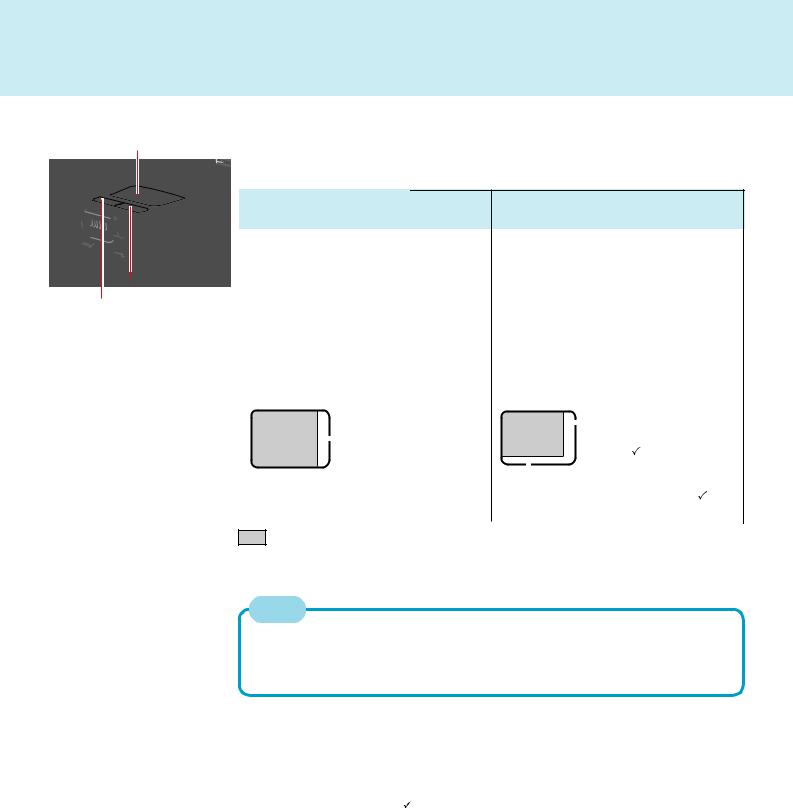
Touch Pad (Advanced)
8
Work Surface |
Use the touch pad to move the cursor on the display and perform normal computer |
|
operations. |
|
The touch pad has the following two modes of operation. |
Right Button 
Left Button
|
Microsoft® IntelliMouseTM Wheel Mode |
|
|
Original Mode |
|
|||||
|
(Setting at the time of purchase) |
|
|
|
||||||
|
|
|
|
|
|
|
||||
|
|
|
|
|||||||
|
Wheel mode operations (almost identical |
Only scroll operation is possible for appli- |
||||||||
|
to the case of using the Microsoft® |
cations not compatible with the Microsoft® |
||||||||
|
IntelliMouseTM for scroll, zoom, etc., op- |
wheel function. |
|
|
||||||
|
erations) are possible for Microsoft® wheel |
Even for applications compatible with the |
||||||||
|
||||||||||
|
function-compatible applications. |
|||||||||
|
Microsoft® wheel function, there are cases |
|||||||||
|
|
|
|
|
||||||
|
Microsoft® IntelliMouseTM is a mouse-type |
where only vertical scrolling or only hori- |
||||||||
|
device that, in addition to the two conven- |
zontal scrolling is possible in this mode. |
||||||||
|
tional buttons, incorporates a wheel able |
|
|
|
|
|
|
|||
|
to rotate forwards/backwards. |
|
|
|
|
|
|
|||
|
Scrolling Area |
Scrolling Area |
|
|
||||||
|
|
|
|
|
|
|
|
Scrolling up/down |
|
|
|
|
|
|
|
|
|
|
|
||
|
|
|
Scrolling up/down |
|
|
|
Possible when a check |
|||
|
|
|
||||||||
|
|
|
|
|
|
|
|
mark |
is added for |
|
|
For the Pan and Auto Scroll functions, the en- |
|
|
|
[Vertical]. |
|
|
|||
|
Scrolling side-to-side |
|
|
|||||||
|
tire work surface of the touch pad can be used |
Possible when a check mark |
is |
|||||||
|
for scrolling. |
added for [Horizontal]. |
|
|
||||||
: Typical mouse operations use this area.
When no check mark is added for [IntelliMouse Wheel mode], [Horizontal] and
[Vertical] of [Scroll Configuration], the entire surface can be used for typical mouse operations.
NOTE
 When the display is rotated, the scroll functions described above will not work.
When the display is rotated, the scroll functions described above will not work.  When you are not sure whether an application is compatible with the Microsoft® wheel function or not, try using both modes. Furthermore, depending on the application, there are cases where scrolling may not be possible with either mode.
When you are not sure whether an application is compatible with the Microsoft® wheel function or not, try using both modes. Furthermore, depending on the application, there are cases where scrolling may not be possible with either mode.
 Changing the mode of the touch pad
Changing the mode of the touch pad
1Select  from the taskbar or select [Mouse] in [start] - [Control Panel] - [Printers and Other Hardware], and then select [TouchPad].
from the taskbar or select [Mouse] in [start] - [Control Panel] - [Printers and Other Hardware], and then select [TouchPad].
2 To set the Microsoft® IntelliMouse™ Wheel mode
To set the Microsoft® IntelliMouse™ Wheel mode
Add the check mark for [IntelliMouse Wheel mode] of [Scroll Configuration].  To set the original mode
To set the original mode
Delete the check mark for [IntelliMouse Wheel mode] of [Scroll Configuration] and then add the check mark  for [Vertical] and/or [Horizontal].
for [Vertical] and/or [Horizontal].
3 Select [OK].
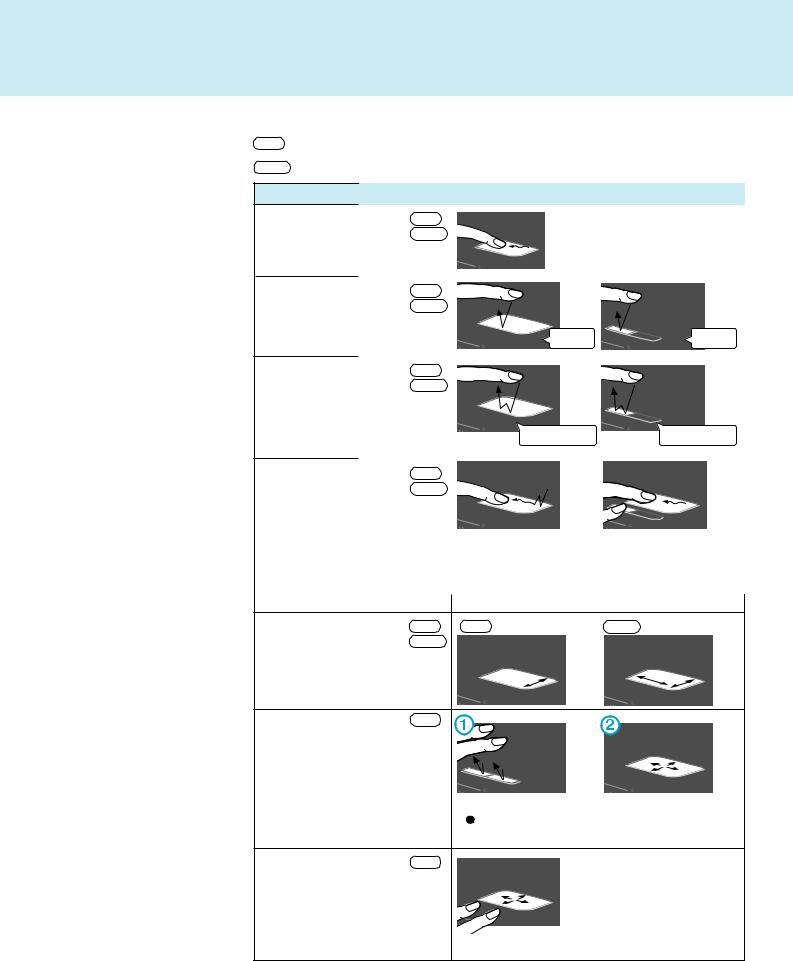
Touch Pad (Advanced)
9
Wheel Indicates an operation applicable to the Microsoft® IntelliMouseTM Wheel mode.
Original Indicates an operation applicable to the original mode.
Function |
|
Touch Pad Operation |
|
Moving the Cursor |
Wheel |
Move the tip of your finger lightly |
|
|
Original |
||
|
|
over the surface. |
|
Tapping/Clicking |
Wheel |
or |
|
|
Original |
|
|
|
|
|
|
|
|
tapping |
clicking |
Double-Tapping/ |
Wheel |
or |
|
Double-Clicking |
Original |
|
|
|
|
||
|
|
double-tapping |
double-clicking |
Dragging |
Wheel |
or |
|
|
Original |
|
|
|
|
|
|
|
|
Two quick taps, but on |
While holding down |
|
|
the second tap leaving |
the button, moving |
|
|
your finger down (ap- |
your finger on the work |
|
|
plying pressure) and |
surface. |
|
|
moving it on the work |
|
|
|
surface. |
|
Scroll* |
Wheel |
Wheel |
Original |
Scroll a document |
Original |
|
|
|
|
|
|
(rotate the wheel) |
|
|
|
Auto Scroll* |
Wheel |
|
|
Automatically scroll a document |
|
|
|
(move the mouse after clicking |
|
|
|
the wheel) |
|
Operate after pressing the two buttons simultaneously. |
|
|
|
||
|
|
When releasing the auto scroll function: |
|
|
|
One tap on the work surface. |
|
Pan* |
Wheel |
|
|
Scroll in various directions of a |
|
|
|
document |
|
|
|
(move the mouse slightly while |
Operate while holding down the two buttons. |
||
holding down the wheel) |
|
||
Within the parentheses () are operations to follow when using an external Microsoft®
IntelliMouse™.
* The movements will differ depending on the application.
(To next page)
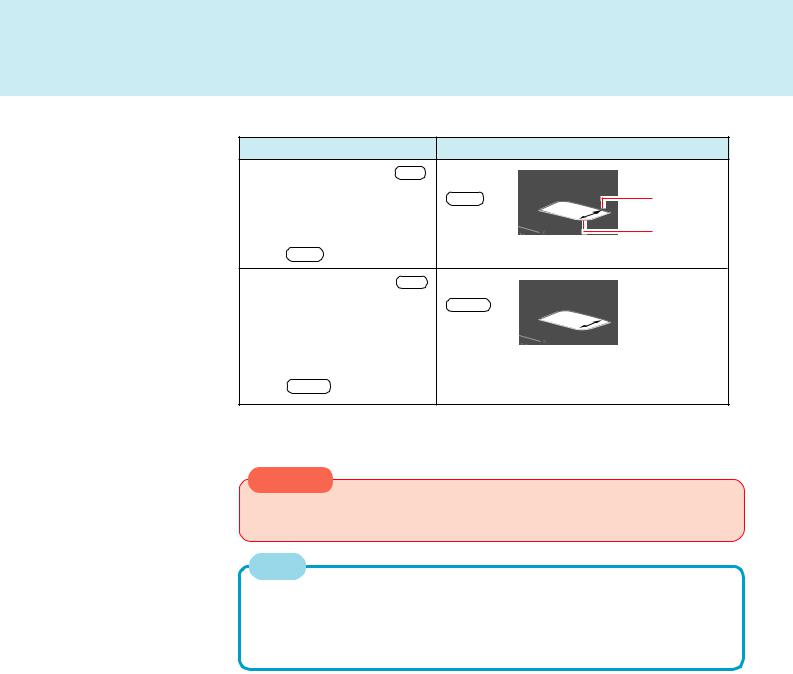
Touch Pad (Advanced)
10
Function |
|
Touch Pad Operation |
|
||
Zoom* |
|
Wheel |
|
|
|
Magnify/reduce the display of |
Ctrl |
+ |
Magnify |
||
|
|
|
|||
a document. |
|
|
|
Reduce |
|
(rotate the wheel while holding |
|
|
|||
|
|
|
|||
down |
Ctrl |
) |
|
|
|
Data Zoom* |
Wheel |
|
|
|
|
Display or hide a document, or |
Shift |
+ |
|
||
perform operations to return to |
|
|
|
||
or proceed with Internet Ex- |
|
|
|
||
plorer. |
|
|
|
|
|
(rotate the wheel while holding |
|
|
|
||
down |
Shift |
) |
|
|
|
Within the parentheses () are operations to follow when using an external Microsoft® IntelliMouse™.
* The movements will differ depending on the application.
CAUTION
Do not remove [touchpad] in [Control Panel] - [Performance and Maintenance] - [System] - [Hardware] - [Device Manager] - [Mice and other pointing devices].
NOTE
 The double-tapping speed of the touch pad can be changed using the following menu.
The double-tapping speed of the touch pad can be changed using the following menu.
[Control Panel] - [Printers and Other Hardware] - [Mouse] - [Tap and Buttons] - [Double-click Speed]
 The touch pad cannot be used in the Setup Utility.
The touch pad cannot be used in the Setup Utility.

Touch Pad (Advanced)
11
 When you want to use an external mouse through the external keyboard/mouse port of the port replicator
When you want to use an external mouse through the external keyboard/mouse port of the port replicator
When an external mouse or trackball with additional functions (e.g., wheel function) is connected, a part or all of the additional functions may fail to operate. To use these additional functions, perform the operation below.
If you are using a USB mouse, the following operation is unnecessary.
1In [Control Panel] - [Add or Remove Programs], select [touchpad] and then select [Change/Remove] to delete it, then select [Yes] to confirm the deletion.
2When the message “The uninstallation was completed.” is displayed, select [OK].
3In [Control Panel] - [Performance and Maintenance] - [System] - [Hardware] - [Device Manager] - [Mice and other pointing devices], select [touchpad], then select [Roll Back Driver] at [Driver].
At the confirmation message, select [Yes].
4Select [Close].
• The display will ask you to restart Windows. Select [No].
5Power off your computer (
 “Starting Up/Shutting Down”) and connect the external mouse or trackball device to the computer.
“Starting Up/Shutting Down”) and connect the external mouse or trackball device to the computer.
6Turn the power on and run the Setup Utility ( page 55). In [Main] menu, set [Touch Pad] to [Disable].
page 55). In [Main] menu, set [Touch Pad] to [Disable].
7 Close the Setup Utility by pressing F10 . At the confirmation message, select [Yes].
8Log on to Windows with the administrator authority (only necessary when multiple accounts are created).
9If the display asks you to restart Windows, select [Yes].
10Following the operating instructions of the connected external mouse, install the necessary driver.

Touch Pad (Advanced)
12
 When you want to re-enable the touch pad
When you want to re-enable the touch pad
1Uninstall the driver or application software of an external mouse or trackball device. (Refer to the operating instructions of the external device on how to uninstall the driver.)
If the explanation of uninstalling the driver or application software can not be found in the operating instructions for the external device, execute the following steps.
In [Control Panel] - [Performance and Maintenance] - [System] - [Hardware] - [Device Manager], when an external mouse or trackball device is displayed in
[Mice and other pointing devices], press Del to delete it and then select [OK] to confirm the deletion.
2The display will ask you to restart Windows. Select [No].
3Power off your computer (
 “Starting Up/Shutting Down”) and remove the external mouse or trackball device.
“Starting Up/Shutting Down”) and remove the external mouse or trackball device.
4Turn the power on and run the Setup Utility ( page 55). In [Main] menu, set [Touch Pad] to [Enable].
page 55). In [Main] menu, set [Touch Pad] to [Enable].
5 Close the Setup Utility by pressing F10 . At the confirmation message, select [Yes].
6Log on to Windows with the administrator authority (only necessary when multiple accounts are created).
7In [Control Panel] - [Printers and Other Hardware] - [Mouse] - [Hardware], select the external mouse or trackball device and then select [Properties].
8Select [Driver] and then select [Update Driver].
9At [Welcome to the Hardware Update Wizard], select [Install from a list or specific location] and then select [Next].
10Select [Don’t search. I will choose the driver to install.] and then select [Next].
11Select [Have Disk], input [c:\util\drivers\mouse] at [Copy manufacturer’s files from], then select [OK].
12Select [touchpad] and then select [Next]. If same item names are displayed, select one. If [xx has not passed Windows Logo testing....] is displayed, select [Continue Anyway].
13Select [Finish] and then select [Close].
14The display will ask you to restart Windows. Select [Yes].
NOTE
When [PS/2 Compatible Mouse] is displayed in [Mice and other pointing devices]:
1Double-click [PS/2 Compatible Mouse].
2Select [Driver] - [Update Driver], then select [Install from a list or specific location (Advanced)], and then select [Next].
3Select [Don’t search, I will choose the driver to install], then select [Next].
4Select [touchpad], then select [Next].
5If the message “Hardware installation” is displayed, select [Continue Anyway].
6Select [Finish], then select [Close].
7The display will ask you to restart Windows, select [Yes].

Touch Pad (Advanced)
13
Handling the Touch Pad
 If a key combination such as Fn + F5 is used while the pad is being touched, the function of the key combination may not work. In addition, it is possible that control of the cursor will be lost and the cursor will not show proper movements. In such cases, the computer has to be restarted by using the keyboard (e.g.,
If a key combination such as Fn + F5 is used while the pad is being touched, the function of the key combination may not work. In addition, it is possible that control of the cursor will be lost and the cursor will not show proper movements. In such cases, the computer has to be restarted by using the keyboard (e.g.,  ).
).  The touch pad is designed to be used with a fingertip only. Therefore, avoid the following actions, which may cause damage to the work surface.
The touch pad is designed to be used with a fingertip only. Therefore, avoid the following actions, which may cause damage to the work surface.
•Placing any object on the work surface
•Pressing down forcefully with sharp-pointed objects (e.g., nails) or hard objects that can leave marks (e.g., pencils and ball point pens)
 Try to avoid having any harmful substances such as oil, come in contact with the touch pad. The cursor may not work properly in such cases.
Try to avoid having any harmful substances such as oil, come in contact with the touch pad. The cursor may not work properly in such cases.
 When the touch pad becomes dirty:
When the touch pad becomes dirty:
Wipe to remove dirt by using a dry soft cloth such as gauze or a soft cloth first applied with detergent diluted with water and then thoroughly wrung.
Do not use benzene or thinner, or rubbing alcohol. Doing so may adversely affect the surface, e.g., discoloration. In addition, do not use commercially-available household cleaners and cosmetics, as they may contain components harmful to the surface.
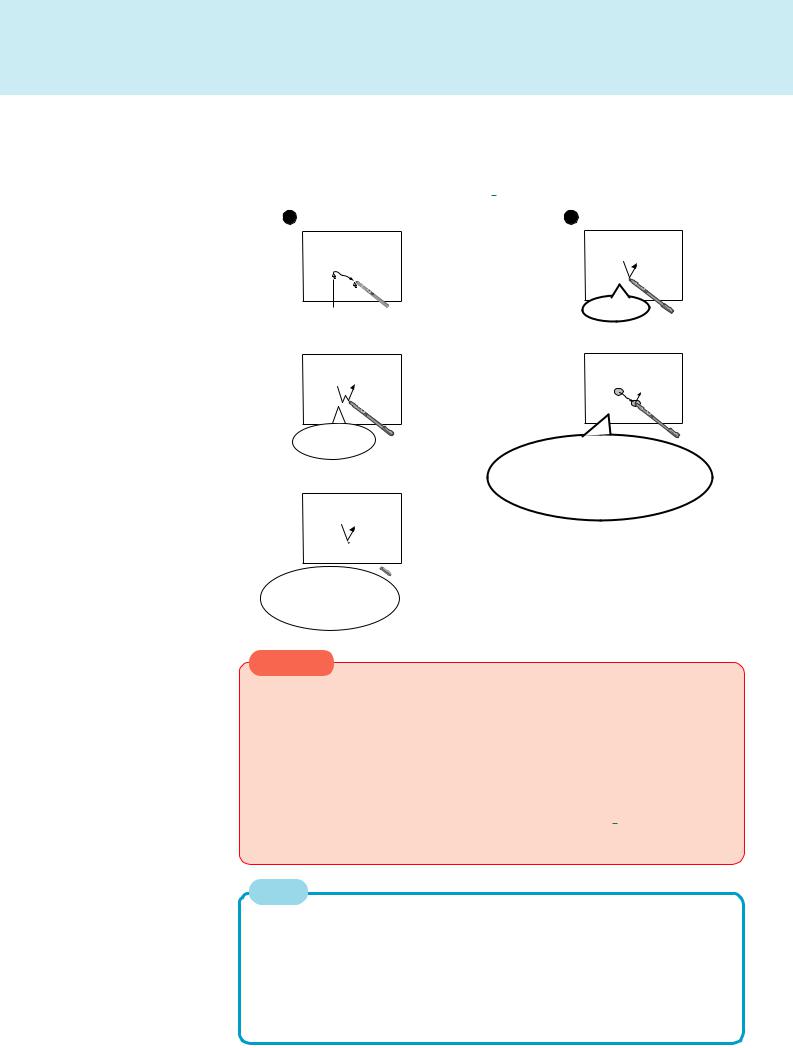
Digitizer (Advanced)
14
Your computer is equipped with a digitizer function allowing you to perform the same operations as the touch pad or mouse by touching the surface of the display with the pen (included). (The following explanation gives one example (for the default settings).
The operation settings can be changed. ( page 15)
page 15)
Moving the cursor |
Clicking |
Cursor Pen
Pen
 Double-clicking
Double-clicking
Two quick taps
 Right-clicking
Right-clicking

 Pen Button
Pen Button
Press and hold down the pen button, then tap the object.
One tap
 Dragging
Dragging
Touch and hold the object (i. e. file or icon), move the pen on the surface (dragging the object to the desired location), then release the pen.
CAUTION
 When the internal LCD is used alone or with an external display simultaneously, the digitizer function cannot be used when the area of either display is set larger than default setting of the display resolution.
When the internal LCD is used alone or with an external display simultaneously, the digitizer function cannot be used when the area of either display is set larger than default setting of the display resolution.
 Even when only an external display is in use, the cursor will move on the external display if you touch the surface of the internal LCD with the pen or bring the pen close to the surface of the internal LCD when the digitizer driver is active. Therefore, do not touch the internal LCD when only an external display is in use.
Even when only an external display is in use, the cursor will move on the external display if you touch the surface of the internal LCD with the pen or bring the pen close to the surface of the internal LCD when the digitizer driver is active. Therefore, do not touch the internal LCD when only an external display is in use.
 If a change is made to the display resolution, or the cursor can not be pointed correctly with the pen, be sure to perform [Calibration]. (
If a change is made to the display resolution, or the cursor can not be pointed correctly with the pen, be sure to perform [Calibration]. ( page 15)
page 15)
 The digitizer function can not be used when using the full screen in [Command Prompt].
The digitizer function can not be used when using the full screen in [Command Prompt].
NOTE
 You can move the cursor by bringing the pen close to the screen, without actually touching the screen’s surface.
You can move the cursor by bringing the pen close to the screen, without actually touching the screen’s surface.
 For information on how to use the pen (included), refer to [Get Going with Tablet PC] in [start] - [All Programs].
For information on how to use the pen (included), refer to [Get Going with Tablet PC] in [start] - [All Programs].
 Do not move the pen too quickly. If the pen moves too quickly, the cursor may be unable to follow its movement.
Do not move the pen too quickly. If the pen moves too quickly, the cursor may be unable to follow its movement.
 If you cannot click on the edge of the screen, hold the pen perpendicular to the display and try clicking again.
If you cannot click on the edge of the screen, hold the pen perpendicular to the display and try clicking again.
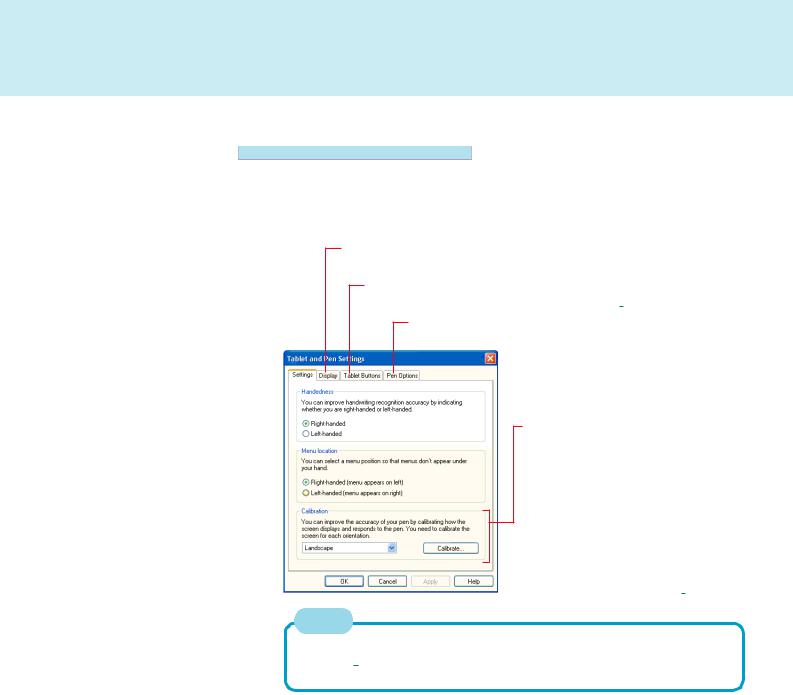
Digitizer (Advanced)
15
Configuring the Digitizer
1 Select  from the taskbar or select [start] - [Control Panel] - [Printers and Other Hardware] - [Tablet and Pen Settings]. The following screen will be displayed.
from the taskbar or select [start] - [Control Panel] - [Printers and Other Hardware] - [Tablet and Pen Settings]. The following screen will be displayed.
Display
Set the display angle and the order of display rotation positions.
Tablet Buttons
Change the settings of the tablet buttons ( page 7).
page 7).
Pen Options
Set the pen actions.
Calibration
Define the calibration setup.
Use when the cursor can not be pointed correctly with the pen. (Needed if the alignment of the digitizer with the visual image change or adjust the display resolution). When you perform the calibration, hold the pen at the same angle as you would when actually using it.
Perform the calibration separately for [Landscape] and [Portrait]. ( page 17)
page 17)
NOTE
 Rotates the display to [Primary landscape] before performing the calibration. (
Rotates the display to [Primary landscape] before performing the calibration. ( page 17)
page 17)
 For more information, refer to [Help].
For more information, refer to [Help].
2 Make necessary changes.
3 Select [OK].

Digitizer (Advanced)
16
Handling the Digitizer
 Use the pen included with the computer. You cannot use an implement other than the pen that comes with the computer.
Use the pen included with the computer. You cannot use an implement other than the pen that comes with the computer.
 Do not place any object on the surface or press down forcefully with sharp-pointed objects (e.g., nails), or hard objects that can leave marks (e.g., pencils and ball point pens).
Do not place any object on the surface or press down forcefully with sharp-pointed objects (e.g., nails), or hard objects that can leave marks (e.g., pencils and ball point pens).
 Do not operate the computer when such things as dust are on the screen. Do not allow contact with substances that could dirty the screen, such as oil.
Do not operate the computer when such things as dust are on the screen. Do not allow contact with substances that could dirty the screen, such as oil.
 When the screen becomes dirty:
When the screen becomes dirty:
Wipe to remove dirt by using a dry soft cloth included with the computer. Do not use benzene or thinner, or rubbing alcohol.
For more information, refer to “Suggestions About Cleaning the LCD Surface” that comes with the soft cloth.
 Because the digitizer uses electromagnetic induction, it may malfunction in locations such as the following, where strong electrical fields or magnetic fields occur:
Because the digitizer uses electromagnetic induction, it may malfunction in locations such as the following, where strong electrical fields or magnetic fields occur:
•Near AM radio base station or relay station antennas
•Near some CRT displays that generate strong electromagnetic field noise
Even if the digitizer does malfunction, it will return to normal operations when the computer is no longer in close proximity to the locations described above.
Handling the Pen
 The pen has a built-in pressure sensor to detect the touch of the pen tip. Avoid strong shocks (such as dropping the pen), excessive pressure on the pen tip, or allowing the pen to become wet. These may result in malfunctions or damage to the pen.
The pen has a built-in pressure sensor to detect the touch of the pen tip. Avoid strong shocks (such as dropping the pen), excessive pressure on the pen tip, or allowing the pen to become wet. These may result in malfunctions or damage to the pen.
 Clean the pen tip and screen prior to operation. Foreign particles can scratch the screen and impede the operation of the pen.
Clean the pen tip and screen prior to operation. Foreign particles can scratch the screen and impede the operation of the pen.
 Use the pen only for the computer screen. Using it for any other purpose may damage the pen and scratch the screen.
Use the pen only for the computer screen. Using it for any other purpose may damage the pen and scratch the screen.
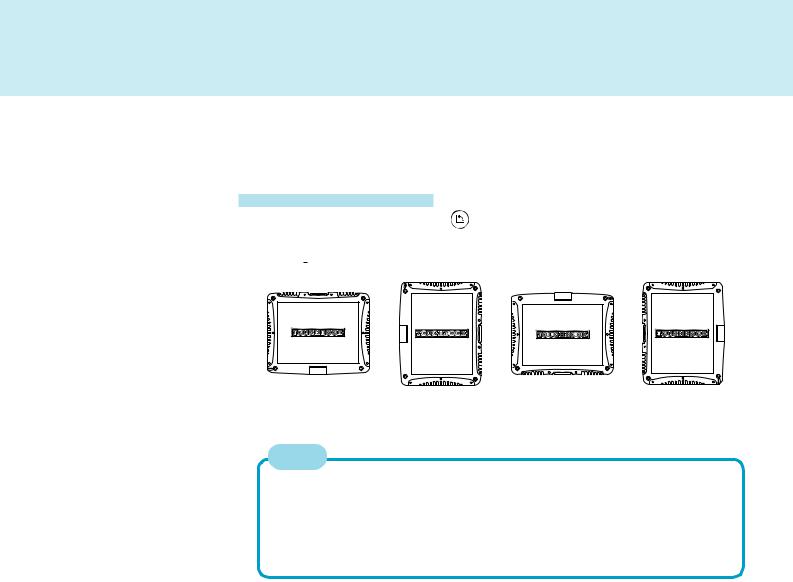
Display Rotation
17
After windows is started up, you can rotate the display and perform the touch pad and digitizer operations in the rotated mode.
Rotating the Display
Press the rotation button .
Each time this button is pressed, the screen display rotates counter-clockwise by 90º. ( below “Changing the Settings”).
below “Changing the Settings”).
|
|
|
|
|
|
|
|
|
|
|
|
|
|
|
|
|
|
|
|
|
|
|
|
|
|
|
|
|
|
|
|
|
|
|
|
|
|
|
|
|
|
|
|
|
|
|
|
|
|
|
|
|
|
|
|
|
|
|
|
Primary |
Secondary |
Secondary |
Primary Portrait |
||||||||
Landscape |
Portrait |
Landscape |
|
|
|
||||||
|
|
|
|
|
|
|
|
|
|
|
|
NOTE
 You can also rotate the display in the following menu.
You can also rotate the display in the following menu.
[start] - [Control Panel] - [Tablet and Pen Settings] - [Display]  Be sure to use the above procedures to rotate the display.
Be sure to use the above procedures to rotate the display.
 If you exit Windows while the display is rotated, the next time Windows is started up, the operation of the touch pad will not match the display angle for a few seconds.
If you exit Windows while the display is rotated, the next time Windows is started up, the operation of the touch pad will not match the display angle for a few seconds.
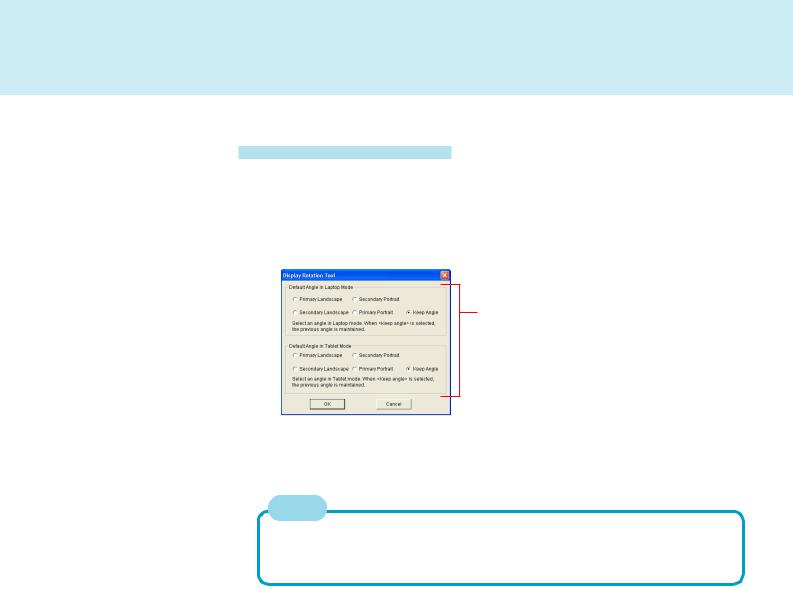
Display Rotation
18
Changing the Settings
By using the Display Rotation Tool, you can change the settings of the display rotation.
1
2
Right-click  on the taskbar, and then select [Setting].
on the taskbar, and then select [Setting].
Change the settings.
In the following cases, the display is automatically set to the default angle.
•When switching from Laptop mode to Tablet
mode, or vice versa (
 “Operating in Tablet Mode”)
“Operating in Tablet Mode”)
•When Windows is started up
•When another user logs on with the Fast User Switching function
3 Select [OK].
NOTE
You can set the order of display rotation positions in the following menu.
[start] - [Control Panel] - [Printers and Other Hardware] - [Tablet and Pen Settings] - [Display] - [Change]

Display Rotation
19
Exiting the Tool
Right-click  on the taskbar, and then select [Exit].
on the taskbar, and then select [Exit].
 If you exit the tool:
If you exit the tool:
•The operation of the touch pad will not match the display angle when the display is rotated.
• The setting of the display rotation (  page 18) will not be effective.
page 18) will not be effective.
 In the default mode, the Display Rotation Tool will start up when Windows starts up.
In the default mode, the Display Rotation Tool will start up when Windows starts up.
 To restart the tool after exiting:
To restart the tool after exiting:
Select [start] - [All Programs] - [Panasonic] - [Display Rotation Tool].
NOTE
 While the display is rotated:
While the display is rotated:
•Do not use the Extended Desktop (The touch pad or the digitizer may fail to operate properly.)
•Do not calibrate the digitizer.
•Do not set the display resolution larger than the resolution of the internal LCD.
•The computer’s performance will decrease somewhat.
 If moving video media is played while the display is rotated, the picture may not be displayed properly or the sound may be broken up. This problem can be corrected by rotating the display to [Primary Landscape].
If moving video media is played while the display is rotated, the picture may not be displayed properly or the sound may be broken up. This problem can be corrected by rotating the display to [Primary Landscape].
 The touch pad scroll, zoom, and data zoom functions do not work while the display is rotated.
The touch pad scroll, zoom, and data zoom functions do not work while the display is rotated.
 The display cannot be rotated when the [Command Prompt] is set to “Full Screen”.
The display cannot be rotated when the [Command Prompt] is set to “Full Screen”.
 If the display is rotated when the resolution is set to 800x600 pixels or 640x480 pixels, depending on the Windows specifications, incorrect values may be shown for the resolution displayed in [Screen resolution] of [Display Properties]. Continue using these settings, without changing [Screen resolution].
If the display is rotated when the resolution is set to 800x600 pixels or 640x480 pixels, depending on the Windows specifications, incorrect values may be shown for the resolution displayed in [Screen resolution] of [Display Properties]. Continue using these settings, without changing [Screen resolution].
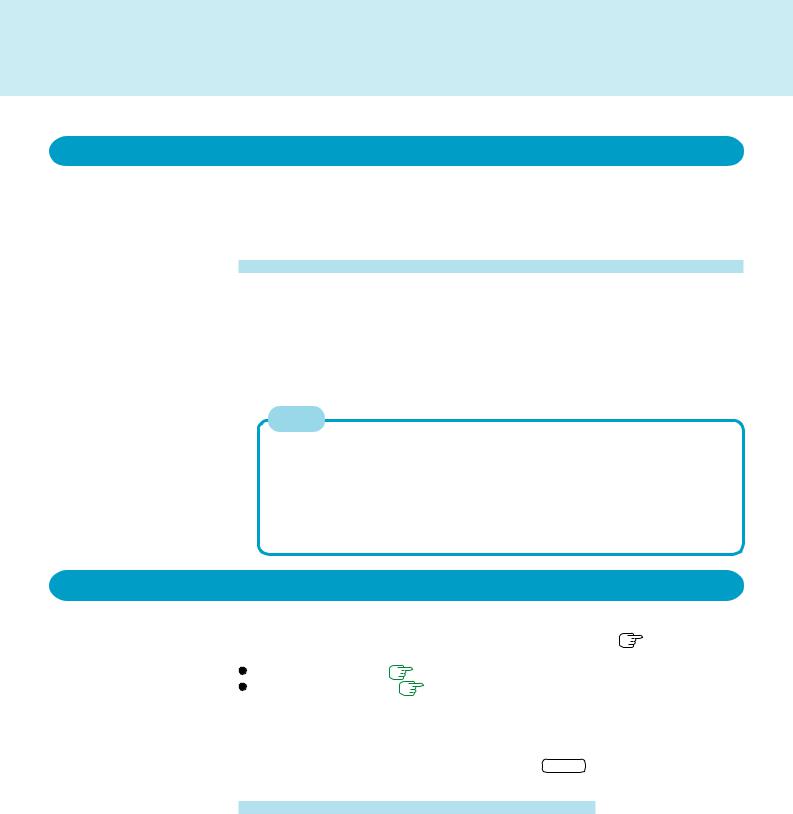
Standby/Hibernation Functions
20
Starting Up Your Computer Quickly
If you use the standby or hibernation function, you can shut down the computer without closing programs and documents. Upon restarting your computer from either the standby or hibernation mode, you can immediately continue working in all programs, or documents that were open at the time the computer was placed into standby or hibernation mode.
Differences between the standby and hibernation functions
Function |
Standby function |
Hibernation function |
Where data is |
Memory |
Hard disk |
saved to |
|
|
Speed |
Fast |
Somewhat slow |
Requires power |
Yes (if power is cut, all data |
Power is not required to main- |
supply |
is lost) |
tain data |
NOTE
 We recommend plugging in the AC adaptor if the standby function is to be used for a long period of time. If the AC adaptor cannot be connected, we recommend that hibernation mode be used instead of the standby mode.
We recommend plugging in the AC adaptor if the standby function is to be used for a long period of time. If the AC adaptor cannot be connected, we recommend that hibernation mode be used instead of the standby mode.
 If the standby or hibernation function is used repeatedly, the computer may not work properly. To stabilize computer operations, we recommend shutting down Windows on a regular basis (about once a week) without using the standby or hibernation function.
If the standby or hibernation function is used repeatedly, the computer may not work properly. To stabilize computer operations, we recommend shutting down Windows on a regular basis (about once a week) without using the standby or hibernation function.
Entering the Standby or Hibernation Mode
Use any of the following methods to enter the standby or hibernation mode.
To use the hibernation mode, make the setting below in advance ( |
below). (Enabled |
|
in factory preset.) |
|
|
Fn key combinations ( |
page 4) |
|
Using the power switch ( |
page 22) |
|
 From the shut down screen:
From the shut down screen:
•Standby
In [start] - [Turn Off Computer], select [Stand By].
•Hibernation
In [start] - [Turn Off Computer], press and hold Shift , then select [Hibernate].
Setting for using the hibernation mode
1Select [start] - [Control Panel] - [Performance and Maintenance] - [Power Options].
2In [Hibernate], add the check mark for [Enable hibernation] and select [OK].

Standby/Hibernation Functions
21
Precautions
 Before entering the standby or hibernation mode
Before entering the standby or hibernation mode
 Save all data.
Save all data.
 When a file in an external device such as a CD drive, external hard disk, or ATA card is opened, close the file.
When a file in an external device such as a CD drive, external hard disk, or ATA card is opened, close the file.
 Even when a password has been set in the Setup Utility, [Enter Password] does not appear when the computer resumes from the standby or hibernation mode. If you want to use the security function when using the standby or hibernation mode, use the Windows password as follows:
Even when a password has been set in the Setup Utility, [Enter Password] does not appear when the computer resumes from the standby or hibernation mode. If you want to use the security function when using the standby or hibernation mode, use the Windows password as follows:
1Select the account to change in [Control Panel] - [User Accounts].
2Set the password.
3Add the check mark for [Prompt for password when computer resumes from standby] in [Control Panel] - [Performance and Maintenance] - [Power Options] - [Advanced].
 Do not enter either the standby or hibernation mode under the following conditions. You may corrupt your data or file, the standby or hibernation function may not work, or the computer (or peripherals) may fail to work properly.
Do not enter either the standby or hibernation mode under the following conditions. You may corrupt your data or file, the standby or hibernation function may not work, or the computer (or peripherals) may fail to work properly.
• When the floppy disk drive being accessed or hard disk drive indicator ( ) is on.
•When playing/recording audio files and displaying images (such as MPEG files).
•When using communications software or the network function.
•When using LAN port (cards), SCSI cards and modem port (cards) etc. (If these cards fail to work properly, restart the computer.)
When entering the standby or hibernation mode*
 Avoid the following:
Avoid the following:
•Using the keyboard, pointing device (touch pad, digitizer, external mouse, etc.), tablet buttons, or power switch.
•Connecting or disconnecting the AC adaptor.
•Closing or opening the display.
*Standby mode: until the power indicator blinks green Hibernation mode: until the power indicator goes off
 In standby or hibernation mode
In standby or hibernation mode
 Do not insert or remove peripherals; abnormal operation may result.
Do not insert or remove peripherals; abnormal operation may result.
 In standby mode, power is consumed. If PC Cards are inserted, more of that power is consumed. When all power has been consumed, all data saved at standby is lost since it is retained in memory. We therefore recommend plugging in the AC adaptor when using the standby function.
In standby mode, power is consumed. If PC Cards are inserted, more of that power is consumed. When all power has been consumed, all data saved at standby is lost since it is retained in memory. We therefore recommend plugging in the AC adaptor when using the standby function.
